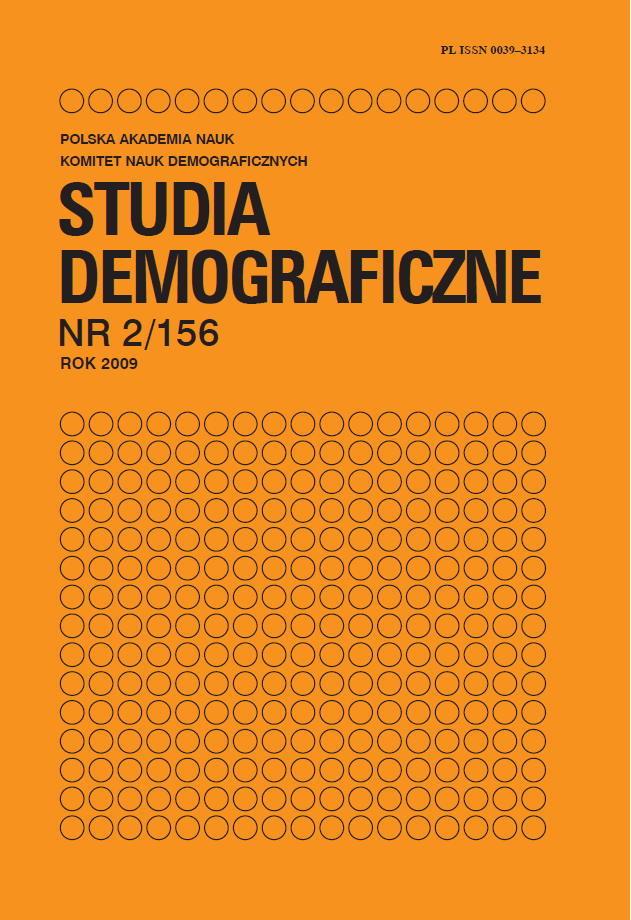Wzory doboru małżeńskiego w Polsce i przyczyny ich powstawania
Main Article Content
Abstract
The article aims to discuss spouse selection patterns, such as homogamy and hypergamy, that can be observed among Polish couples. It is shown how these patterns have evolved in the last decades, from 1975 to 2008. Attempt has been made to explain, why these marriage patterns emerge and what this can tell us about the society. As status homogamy entails mating within one’s own status or social group, it is considered to be an indicator of openness of status groups and of social stratification. The paper touches upon the rigidity of social structure in Poland that was assessed by the analysis of marriage patterns. The study focuses on socioeconomic characteristics of potential partners, i.e. social origin (parental status), education level and occupational status. The results suggest that Poles show some preference of partner’s achieved status, which includes education level and occupation, whereas social origin does not seems to be relevant for spouse selection. However, the strength of homogamy seems to have declined over the past thirty years. The results of analysis do not support the existence of educational hypergamy in Poland and fail to give a clear answer in case of occupational status, which is rather uncommon on a global scale. Calculations were based on loglinear models and correspondence analysis.
Article Details
References
[2] Becker G.S., 1990, Ekonomiczna teoria zachowań ludzkich, PWN, Warszawa.
[3] Bokszański Z. (red.), 1999, Encyklopedia socjologii, Oficyna Naukowa, Warszawa, t. 1.
[4] Buss D.M., 1996, Ewolucja pożądania – strategie doboru seksualnego ludzi, Gdańskie Wydawnictwo Psychologiczne, Gdańsk.
[5] Domański H., Przybysz D., 2003, Analiza przydatności EGP jako wskaźnika pozycji społecznej, „Ask. Społeczeństwo, Badania, Metody”, nr 12, 85–116.
[6] Domański H., Przybysz D., 2007, Homogamia małżeńska, a hierarchie społeczne, Wydawnictwo IFiS PAN, Warszawa. Domański H., Przybysz D., 2009, Bariery zawierania małżeństw w Polsce, „Studia Socjologiczne” nr 1(192), 53–87.
[7] GUS (różne lata), Rocznik Demograficzny z lat 1945–1966, 1967–1968, 1976, 1981, 1986, 1991, 1996, 2000, 2005, 2006, 2007, 2008, Warszawa.
[8] GUS, 2001, Mały Rocznik Statystyczny Polski 2000, Warszawa.
[9] GUS, 2007, Rocznik Statystyki Międzynarodowej 2006, GUS, Warszawa.
[10] GUS, 2010, Mały Rocznik Statystyczny Polski 2009, Warszawa.
[11] Janczewska M., Klinger K. 2008, Konserwatyzm młodego pokolenia. Dla Polek rodzina jest ważniejsza od kariery, zasób internetowy, http://wiadomosci.dziennik.pl/wydarzenia/artykuly/126999,dla-polek-rodzina-jest-wazniejsza-od-kariery.html (data dostępu: 01.2010).
[12] Kalmijn M., 1991, Status Homogamy in the United States, „American Journal of Sociology”, Vol. 2(97), 496-523.
[13] Kalmijn M., 1998, Intermarriage and homogamy, „Annual Review of Sociology”, Vol. 24, 395-421.
[14] Kotowska I.E., Sztanderska U., 2007, Zmiany demograficzne, a zmiany na rynku pracy w Polsce, [w:] I.E. Kotowska, U. Sztanderska, I. Wóycicka(red.), Aktywność zawodowa i edukacyjna a obowiązki rodzinne w Polsce w świetle badań empirycznych, Wydawnictwo Naukowe SCHOLAR, Warszawa, 13–47.
[15] Marshall G. (red.), 2004, Słownik socjologii i nauk społecznych, Wydawnictwo Naukowe PWN, Warszawa.
[16] Oppenheimer V.K., 1988, A Theory of Marriage Timing, „American Sociological Review”, Vol. 3(94), 563–591.
[17] Przybysz D., 2004, Modele logarytmiczno-liniowe dla zmiennych porządkowych, „ASK. Społeczeństwo. Badania. Metody” , nr 13, 51–85.
[18] Smits J., Ultee W., Lammers J., 1998, Educational homogramy in 65 countries: an explanation of differences using country explanatory variables, „American Social Review”, Vol. 2(63), 264–285.
Strony internetowe:
[1] www.diagnoza.com, (data dostępu: 06.2009)
[2] www.europeansocialsurvey.org, (data dostępu: 06.2009)
[3] www.stat.gov.pl, (data dostępu: 01.2010)
